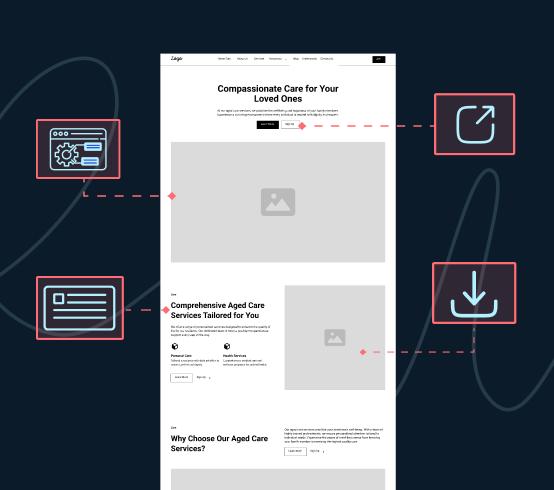
Website optimisation involves fine-tuning various aspects of your online platform to enhance its performance, user experience and visibility on search engines. By optimising your website, you can improve its loading speed, usability, and overall design, ensuring that it resonates with your target audience and compels them to take action.
In this article, we will delve into the world of website optimization and explore proven techniques to boost both traffic and conversions. Whether you’re an entrepreneur looking to establish an online presence or a seasoned marketer aiming to maximise your website’s potential, the insights and strategies shared here will provide you with a solid foundation to optimise your website effectively.
From search engine optimisation (SEO) tactics that elevate your website’s visibility in search results to conversion rate optimisation (CRO) techniques that fine-tune your user experience, we will cover a comprehensive range of optimization strategies. Additionally, we will discuss the significance of compelling content, mobile optimization, and user engagement to create a seamless and captivating online experience for your visitors.
Throughout this article, we will provide practical tips, best practices, and actionable steps that you can implement to drive targeted traffic to your website and increase conversions. By optimising your website holistically, you can achieve sustainable growth, expand your reach, and ultimately, achieve your business goals.
So, if you’re ready to unlock the full potential of your website and transform it into a high-performing platform that drives results, let’s dive into the realm of website optimisation and discover the strategies that will revolutionise your online presence.
What is Website Optimisation?
Website optimisation is the process of making adjustments to your website in order to enhance its functionality, visibility and user experience. Website optimisation aims to bring in more people, keep them engaged on your site and eventually convert them into paying customers or clients.
A combination of strategies may be used for website optimisation, such as modifying your online content for search engines, speeding up the loading process and enhancing the UI and UX of your site. These strategies require investment, but the cost of maintaining a website can be worth it if it leads to increased traffic and brand exposure, improved user engagement and higher conversion rates.
Why Website Optimisation is Important
Website optimisation is the most organic way to reach your target audience. By using relevant keywords, you can understand what your audience is searching for and provide them with related content. For example, if you’re selling basketball shoes, you can use the keyword “red basketball shoes for men” as the item’s description. And once your target customer searches for this specific term, they’re likely to land on a website that offers information about that red basketball shoe.
Website optimisation is not all about delivering the related result but also providing your actual users with good website performance with a smoother experience and faster load times. This can be done by analysing and changing the way your content displays on the screen, ensuring that it is easy for visitors to navigate, and reducing the waiting time, especially for mobile users.
Benefits of Website Optimisation
Website optimisation is essential for maximising performance and achieving desired outcomes. Here are some benefits of website optimisation that you should know:
- Improved amount of traffic that your website receives, mainly through organic search
- Higher conversion rates as a result of a more engaging and compelling website
- Enhance user experience, leading to an increase in engagement and visitor interaction.
- Increase brand awareness and reputation through higher search engine rankings.
- Cost-effective marketing in comparison to other advertising methods.
- Increased website speed, reducing bounce rates and improving user experience
- Higher search engine rankings through optimised content and structure
- Better user engagement through a well-designed and user-friendly website
- Growth in revenue and profitability as a result of increased traffic and conversions
- Maintain a competitive advantage in your industry by keeping your website well-optimised and ahead of your competitors
How to Optimise Your Website Effectively
Optimising your website is more than simply adding bright graphics or beautiful fonts; it involves creating a smooth user experience that increases the visibility of your website and promotes your online presence. You can boost your website’s organic traffic and enhance its search engine rating with the correct optimisation strategies.
Useful Tips for Web Optimisation
Due to the growing dependence of society on the internet, businesses need to make sure that their websites are optimised to reach their target audience efficiently. Here are some valuable tips to make your optimisation successful.
- Conduct extensive keyword research to find the terms and phrases that are relevant to your business.
- Use responsive design to be sure that your website looks good on mobile devices.
- Optimise your website’s loading speed by reducing image file sizes, minimising the use of plugins, and using a content delivery network (CDN).
- Create high-quality content for your target audience.
- Use multimedia contents like images, videos, and infographics to make your material more interesting.
- Use internal linking to link to relevant content on your website and help search engines understand the context of your content.
- Use header tags to organise your information and make it simpler for search engines to read (H1, H2, H3).
- Improve your website’s title tags and meta descriptions to give an easy-to-understand overview of the content.
- Use descriptive alt tags and file names that contain your target keywords to optimise your images.
- Make your content shareable on social media by including social sharing buttons on your website.
- Regularly update your website’s content to keep it fresh.
- Utilise website analytics tools to track the effectiveness of your website and make data-driven choices to improve it.
- Simplify the navigation on your website to make it simple for users to find what they’re searching for.
Let Butterfly Empower Your Website With Effective Optimisation Strategies
Conducting a Website Audit
Before optimising your website, conduct a website audit to identify its strengths and weaknesses. You can use analytic tools like Google Analytics to study the site’s technical and content aspects, including its structure, user interface, design, speed, mobile-friendliness, and user experience.
Improve Website Speed
Optimise your website’s loading speed by compressing images, minifying code and leveraging browser caching. A fast-loading website not only improves user experience but also positively impacts search engine rankings.
Keyword Research & Optimisation
There are several tools (paid for and free) that help you to identify the correct keywords to target for you audience With these kinds of tools for keyword research, you can easily find keyword opportunities that can be integrated with your content.
Enhance User Experience
Ensure your website is user-friendly by focusing on intuitive navigation, clear calls-to-action and an attractive design. Make sure your website is mobile-responsive, as an increasing number of users access the internet through mobile devices. Improve readability by using legible fonts, appropriate font sizes, and ample white space.
Content Optimisation
This refers to the techniques and strategies employed directly on the web pages of a website to improve its visibility and relevance to search engines. It involves optimising various on-page elements, such as meta tags, headings, URLs, and content, to align with targeted keywords and provide a better user experience. On-page optimisation also involves ensuring proper keyword usage, creating engaging and valuable content, optimising images and multimedia, and improving overall website structure and navigation.
On-Page Optimisation
This refers to the techniques and strategies employed directly on the web pages of a website to improve its visibility and relevance to search engines. It involves optimising various on-page elements, such as meta tags, headings, URLs, and content, to align with targeted keywords and provide a better user experience. On-page optimisation also involves ensuring proper keyword usage, creating engaging and valuable content, optimising images and multimedia, and improving overall website structure and navigation.
Optimise for Conversions
Streamline your conversion funnel by simplifying the checkout process, minimising form fields, and incorporating trust signals, such as customer testimonials and security badges. Use compelling and persuasive copy to guide visitors towards desired actions.
Testing and Analytics
Website optimisation uses data to improve a website’s performance experience. This includes setting up analytics tools to track key performance metrics, test website speed, use heat mapping, and conduct A/B testing. This data will provide valuable insights into user behaviour, allowing you to make informed decisions for further optimisation. Using these strategies, businesses can attract more audiences, increasing conversion rates.
Regularly Update and Maintain
Continuously update and maintain your website by regularly adding fresh content, ensuring all links are working, and staying up-to-date with security patches and software updates. Regular maintenance keeps your website secure, reliable, and optimised for performance.
Optimise Your Website With Butterfly
Butterfly is a leading web development agency in Melbourne that can empower your website with effective optimisation strategies. With years of experience in web development and optimisation, we know what it takes to create not only visually appealing websites but also optimised for search engines. With our proven optimisation strategies, we can help you achieve your business goals and drive more conversions. Call us now and find out more about our services and how we could help you in achieving your online goals.
Website Optimisation FAQs
What does website optimisation do?
Website optimisation employs keyword research, content creation, on-page and off-page optimisation, testing, and analytics to help businesses’ websites rank higher in search engine results. This strategy can draw in more visitors and enhance the chances that those visitors will take the action of making a purchase.
How much does it cost to optimise a website?
How do I know if my website is optimised?
What is the most important website optimisation element?
The most important website optimisation element is web design. It encompasses the visual appeal, layout, and functionality of a website, playing a crucial role in attracting and engaging visitors. An optimised web design ensures a positive user experience, promoting higher engagement and conversions.




